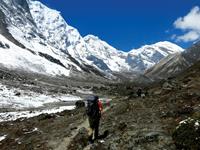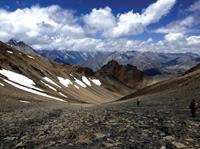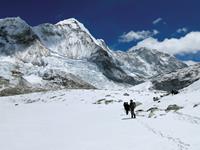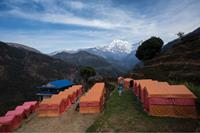Blog home / Tips for Communicating in Remote Areas of Nepal
About to embark on a trek in the remote areas of Nepal and not sure what devices to use for communicating with family and friends back at home? Or are you itching to blog about your experience but you don’t want to wait until you reach the next internet café to share your incredible experiences?
World Expeditions Himalaya expert Gavin Turner has shared his top tips for communicating in remote areas of Nepal. Gavin has spent almost 18 years studying and working in the Himalaya and has completed 30 treks and climbs across the region.
So, whether you are someone who wants occasional contact to the outside world, or someone who wants 24/7 access, Gavin has shared a number of options available to you!
 Gokyo Lake, Nepal - Photo by Ray Mustey on the Great Himalaya Trail
Gokyo Lake, Nepal - Photo by Ray Mustey on the Great Himalaya Trail
For those who want occasional phone usage...
-
Pre-Paid Ncell SIM card (limited access to reception)
For those who are after occasional phone usage, I recommend purchasing an Ncell pre-paid SIM card in Kathmandu.
NCell is a local telecommunications company and their SIM Cards are easy to arrange. Use it in an unlocked iPhone or similar smartphone and you have the functionality of your phone (calls and data) wherever there is cell phone reception. The stronger the reception the greater the likelihood that data will work. Weak reception = no data.
There are various rates and packages available with NCell and you should enquire to make sure they are on a package with lower data and phone charges. World Expeditions staff members are available to support where necessary.
 Lovely verdant landscape within Kali Gandaki valley - Dolpo Region, Nepal
Lovely verdant landscape within Kali Gandaki valley - Dolpo Region, Nepal
-
Buy plenty of recharge cards
Purchase ample recharge cards (either the Rs500 or Rs1000 cards) to last the duration of the trek. Buy plenty if you think you’ll be using lots of data. Again, enquire locally in Kathmandu.
-
Be aware that reception will not always be available
Be aware that your unlocked smartphone with a local NCell SIM card will only work where there is local cell phone reception. For much of the Great Himalayan Trail, trekking through isolated mountain regions, there will be no reception. Other areas, like Everest and Annapurna, cell phone reception is widespread, but unreliable and prone to issues.
 Icy mountain side while trekking towards Tashi Labsta - Parchemuche Tsho, Nepal
Icy mountain side while trekking towards Tashi Labsta - Parchemuche Tsho, Nepal
For those who want 24/7 access to the outside world...
Having been on a number of long expeditions I can attest to how good it feels to make a call back home. Nowadays, with satellite technology widely available, that is always possible. For people intent on blogging or who simply want to be able to make a call to their family whenever they want, one of these two options are the way to go.
-
Purchase a satellite phone
For Nepal, both Thuraya and Motorola satellite phones have good coverage.
-
Purchase a Thuraya SatSleeve that turns your iPhone into a satellite phone.
This cool device gives you all the functionality of your iPhone via satellite, which means you are not waiting for the next village on the trail, maybe days away, to access the internet, update your blog, or make a call back home.
Find out how to turn your iphone into a satellite.
 Beautiful rocky landscapes while crossing Thorong La - Annapurna Ranges, Nepal
Beautiful rocky landscapes while crossing Thorong La - Annapurna Ranges, Nepal
Useful hint - bring your own solar charger.
If charging devices is important to you, there is no substitute for a solar charger. Electricity supply can be unreliable in remote parts of Nepal, and unavailable for the majority of some treks like the Great Himalayan Trail. Prices have dropped considerably on portable solar charges in recent years. I recommend Goal Zero which you will see on major expeditions throughout the Himalaya and elsewhere.
Do your research and weigh up what will work best for you.
The bottom line is, do your research, consider your options and make sure you bring all the different plugs and adapters that are necessary for maintaining their digital devices out on the trail.
 Trekking the snowy fields back towards Ghunsa on the Great Himalaya Trail, Nepal.
Trekking the snowy fields back towards Ghunsa on the Great Himalaya Trail, Nepal.
Trekking in Nepal With World Expeditions
World Expeditions has been operating in Nepal since 1975, and we have pioneered unique and unrivaled trekking and touring itineraries for all fitness levels that showcase our experience and speak to our reputation as the Himalayan trekking specialists. We are committed to sustainability and strive to keep our environmental footprint as small as possible.
To ensure we are sustainable as possible, we have built permanent eco campsites in the Everest and Annapurna regions of Nepal. These campsites give travelers a truly unique and comfortable experience, while also minimising our footprint.
 World Expeditions private eco campsites at Landruk in the Annapurna region, Nepal.
World Expeditions private eco campsites at Landruk in the Annapurna region, Nepal.
About The Author
Gavin Turner, World Expeditions Himalaya Operations Manager
Gavin has spent much of the last 18 years travelling, studying and working in the Himalaya. He has completed more than 30 treks and climbs throughout the Himalaya, where he also has many years experience as a trekking guide and director of study abroad programs for overseas university students.
Highlights have included several visits to Tibet, multiple visits to the classic Everest, Annapurna and Langtang regions of Nepal, and countless rugged journeys through the stunning landscapes of the Indian Himalaya. Gavin is also an accomplished high altitude mountaineer, and has climbed widely in the great ranges of the world, including reaching the summit of 8201m Cho Oyu, the world’s 6th highest mountain.